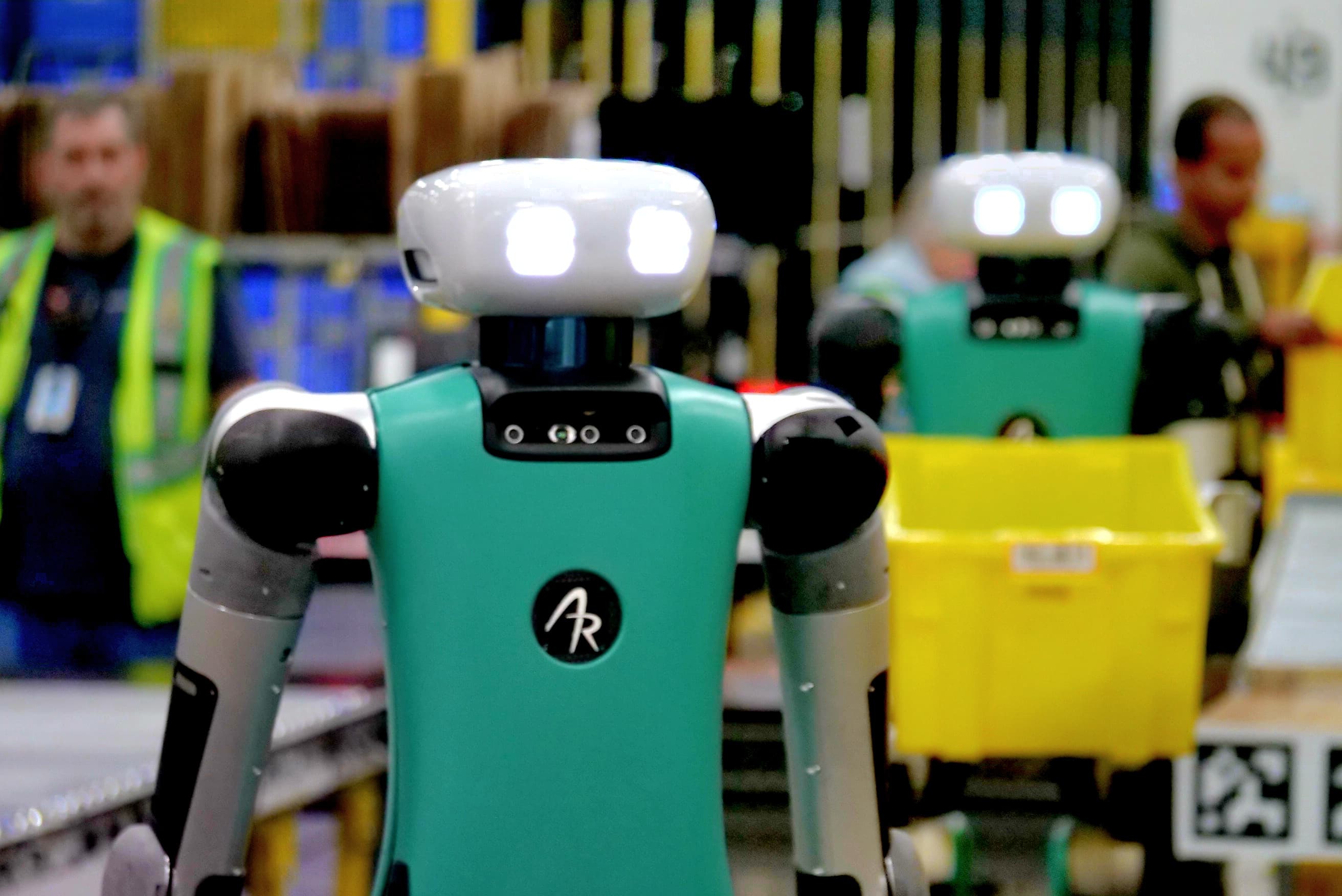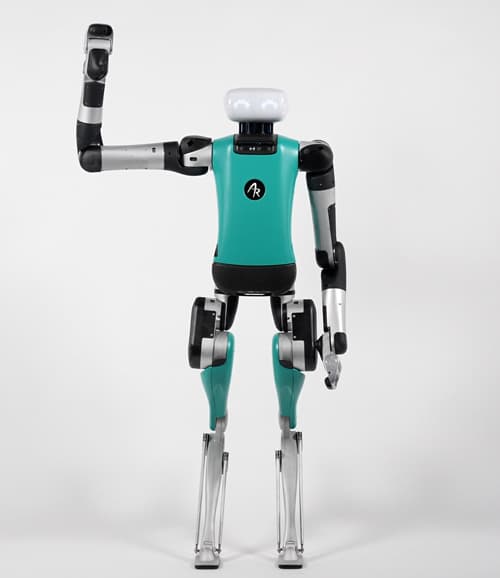
Digit Humanoid Robot
Digit is Agility Robotics' humanoid robot designed for industrial logistics and warehouse automation. Standing 175 cm and weighing 64.8 kg, it autonomously handles tasks like tote recycling and AMR unloading. As the first commercially deployed humanoid, it is managed by the Agility Arc cloud platform and is available to commercial partners via a RaaS subscription or direct fleet purchase.
Quick Stats
| Price | $250K |
| Availability | Available |
| Model Year | 2023 |
| Height | 175 cm |
| Weight | 64.8 kg |
| Degrees of Freedom | 28 DOF |
| Battery Runtime | 4 hours |
| Walking Speed | 1.5 m/s |
About Digit
Digit is a bipedal, humanoid robot created by Agility Robotics. It is designed to work in human environments, specifically warehouses and logistics facilities, to automate "highly repetitive tasks." Its primary, documented tasks are moving warehouse totes, including "tote recycling" and "loading/unloading" Autonomous Mobile Robots (AMRs). Digit represents the world's first commercially deployed humanoid robot, operating in paid pilot programs with major companies like Amazon and GXO Logistics.
Additional Information
Design Philosophy: Pragmatism Over Purity
Agility Robotics' design philosophy for Digit is "human-centric" but, critically, not human-mimetic. The robot's design is a case study in pragmatic, market-driven engineering, solving for the immediate commercial need (warehouse logistics) rather than the abstract, long-term "general purpose" problem.
Biomimetic Legs: Digit's "backward" or "bird-like" legs are its most distinct feature. This design is a direct descendant of Agility's first robot, Cassie, and is biomimetically modeled on flightless birds like the cassowary. This kinematic structure is demonstrably more energy-efficient and dynamically stable for bipedal locomotion than a human-like leg, forming the core of Agility's mobility-first IP.
Task-Specific Hands: The most significant pragmatic design choice is the rejection of complex, five-fingered hands. The 2023 "next generation" model features newly designed end effectors, or hands, that are optimized for grabbing and moving plastic totes. By constraining the manipulation problem to a standardized object (the tote), Agility dramatically simplifies the hardware, software, and AI challenges. This focus is a primary reason Digit is "commercially deployed" while competitors chasing general-purpose grasping remain in R&D.
Communicative Head: The 2023 model's head and eyes are not for sensing; the primary LiDAR and depth cameras are located in the torso. The head and animated LED "eyes" are exclusively for Human-Robot Interaction (HRI). They signal the robot's status and intent (e.g., direction of gaze, "I am turning") to human co-workers. This is a critical feature for "cooperative safety," making the robot's movements predictable and increasing its acceptance in a shared human workspace.
Unique Technical Features: The Industrial-Grade Stack
Digit is engineered as an industrial asset, not a research platform. This is most evident in its navigation and safety systems.
Navigation Stack: The robot's navigation stack was recently redesigned for real-world efficiency. It now uses a model-predictive controller to precisely track a globally optimal, minimum-step path. This technical upgrade provides tangible benefits: fewer steps during tight turns, better performance while carrying heavy objects, and dependable maneuverability in confined spaces—all essential for a functioning warehouse aisle.
Industrial Safety Bus: The inclusion of industrial-grade safety components is a profound differentiator. The 2024 model features a Safety PLC, a Category 1 (CAT1) Stop, and FailSafe over EtherCAT (FSoE). This means the robot's internal "nervous system" is a safety-rated, deterministic, real-time bus. This is not a consumer-grade system; it is a high-reliability architecture built to pass certification (like UL 1740) and operate safely in OSHA-regulated environments.
AI & Autonomy: The Hierarchical AI Stack
Agility's "secret sauce" is not a single, monolithic AI but a complex whole-body control hierarchy. This stack intelligently divides the problem of autonomy into four distinct layers:
Layer 1: Physical AI (The "Motor Cortex"): This is Agility's most proprietary layer. It is a whole-body control foundation model—a small neural network—trained purely in simulation. Using NVIDIA Isaac Sim and Isaac Lab, Agility puts the Digit model through billions of simulated interactions to learn one skill: how to not fall down. This reinforcement-learning model allows the robot to "shrug off bumps," manage disturbances, and transfer "zero-shot" (with no real-world re-training) to the physical robot.
Layer 2: Planning AI (The "Cerebellum"): This is the execution layer, which includes the model-predictive navigation controller and grasp-planning logic.
Layer 3: Semantic AI (The "Cognition"): This top layer uses LLMs and vision models to understand complex, high-level commands. Agility's CTO pragmatically refers to this layer as a "commodity," indicating they can plug in new models as they evolve, while their true focus is on the "Physical AI."
Layer 4: Coordination AI (The "Frontal Lobe"): This is the Agility Arc platform. It coordinates the fleet of robots, communicates with the WMS, and orchestrates tasks between robots (e.g., Digit and AMRs).
This entire stack runs locally on the robot's onboard NVIDIA Jetson AGX Thor compute module, enabling the powerful, real-time decision-making required for "Physical AI."
Practical Operation: From Pilot to Deployment
Digit is "the world's first commercially deployed humanoid robot" based on paid, real-world pilot programs that provide a critical feedback loop for development.
Amazon Pilot (October 2023): Digit was deployed at Amazon's robotics R&D facility. Its initial task is "tote recycling"—a highly repetitive process of picking up and moving empty totes.
GXO/Spanx Pilot (December 2023): This deployment is more complex. At a Spanx facility managed by GXO, Digit is documented moving totes filled with products off of autonomous mobile robots (AMRs) and onto a conveyor. This demonstrates a crucial capability: robot-to-robot collaboration (Digit + AMR) orchestrated by the Agility Arc platform.
These real-world deployments are what drive Agility's pragmatic innovation, leading directly to features like the tote-optimized hands and the industrial safety stack.
Connectivity & Updates: The Cloud-Managed Fleet
Digit is a cloud-native industrial asset. Each robot connects via WiFi to the Agility Arc platform. Arc is the central nervous system for the entire fleet, giving customers "complete control of your robots." It handles facility mapping and workflow definition and, most importantly, provides standard APIs for integration with existing Warehouse Management Systems (WMS) and Warehouse Execution Systems (WES). This architecture allows Agility to push software updates, new "skills," and improved AI models to the entire fleet remotely, enabling the robots to improve over time.
History
- 2016: Agility Robotics' predecessor bipedal robot, Cassie, is created as a research platform at Oregon State University
- 2017: Digit v1 is created, adding a torso to the Cassie leg platform
- 2019: Digit v2 is created, representing the first version with arms
- February 19, 2019: Digit (v2) is publicly unveiled, adding a 4-DOF upper torso, arms, sensors, and additional computing to the Cassie design
- January 2020: The first commercial version of Digit (v2) is launched, available for sale in the "low-mid six figures." Ford Motor Company becomes the first customer, purchasing two units for last-mile delivery research
- 2021: Digit v3 is created
- May 11, 2022: The predecessor, Cassie, sets the Guinness World Record for the fastest 100 meters by a bipedal robot (24.73 seconds), demonstrating the platform's mastery of dynamic locomotion
- 2023: Digit v4 (the "next generation" model) is created
- March 20, 2023: The "next generation" of Digit is unveiled at ProMat 2023. This is the first version with its current "human-centric" design, including newly designed tote-optimized hands and a head with animated eyes for HRI
- October 2023: Agility announces its first major pilot program with Amazon to test Digit for "tote recycling" in its R&D facilities
- December 2023: Agility announces a commercial pilot with GXO Logistics at a SPANX facility, where Digit unloads totes from AMRs onto conveyors
- March 11, 2024: The Agility Arc cloud automation platform is officially launched to manage, deploy, and integrate Digit fleets
- April 2024: Agility announces new innovations for the commercial model, including an "up to 4 hours" battery, autonomous docking, and a full industrial safety stack (CAT1, Safety PLC, FSoE)
- Fall 2024 (Planned): Agility Robotics CEO Peggy Johnson signals a "next generation" of Digit will be released, with an increased payload from 35 lbs to 50 lbs (22.6 kg)






Technical Specifications
Physical Specifications
- Height
- 175 cm
- Width
- Not Disclosed
- Depth
- Not Disclosed
- Weight
- 64.8 kg
- Materials
- Not Disclosed
Performance
- Walking Speed
- 1.5 m/s
- Running Speed
- Not Disclosed
- Max Speed
- 5.4 km/h
- Payload Capacity
- 15.8 kg
- Max Carry
- Not Disclosed
- Max Lift
- Not Disclosed
Degrees of Freedom (DOF)
- Total DOF
- 28
- DOF per Arm
- 4
- DOF per Leg
- Not Disclosed
- DOF per Hand
- 0
- DOF Waist
- Not Disclosed
- DOF Neck
- Not Disclosed
- DOF Spine
- Not Disclosed
Battery & Power
- Battery Type
- Not Disclosed
- Battery Capacity
- Not Disclosed
- Battery Capacity
- 1 kWh
- Battery Voltage
- Not Disclosed
- Battery Runtime
- 4 hours
- Swappable Battery
- No
- Charge Time
- 2 hours
- Charging Method
- Autonomous docking
Computing
- Processor
- Not disclosed
- GPU
- NVIDIA Jetson AGX Thor
- RAM
- Not Disclosed
- Storage
- Not Disclosed
- AI Compute
- Not Disclosed
- Operating System
- Linux-based real-time operating system
- Programming Languages
- C++ (inferred from community forums), primary interface via Agility Arc API
Did You Know?
Latest News
Recent updates and coverage about Digit